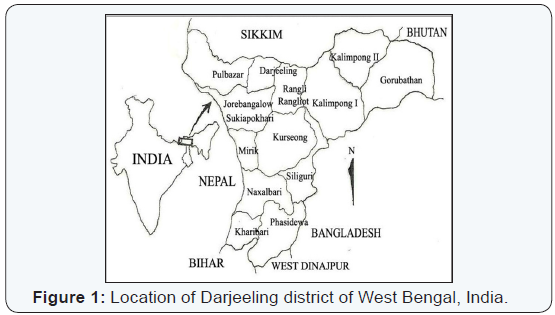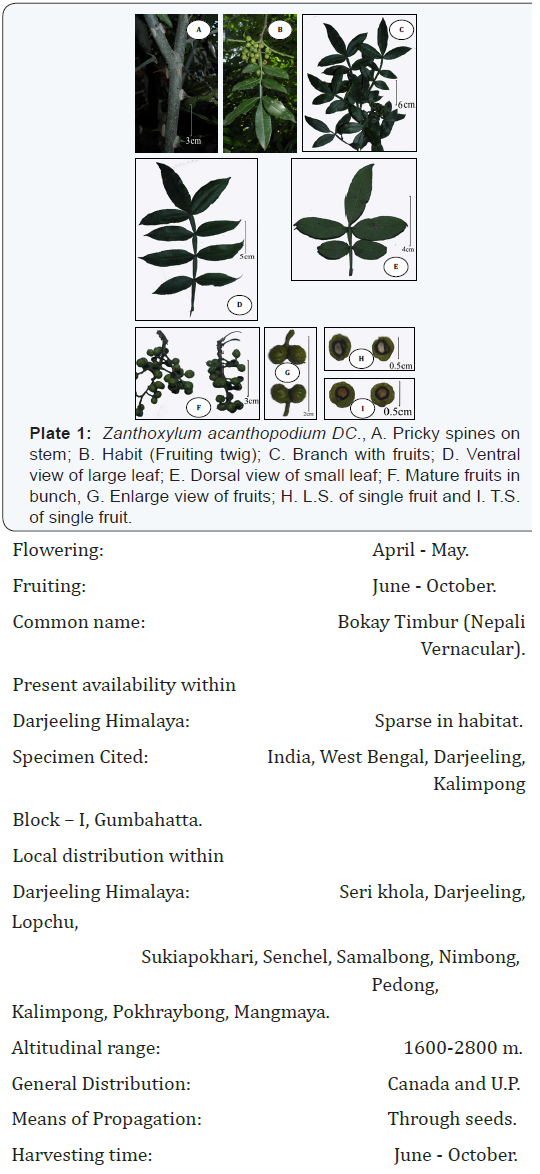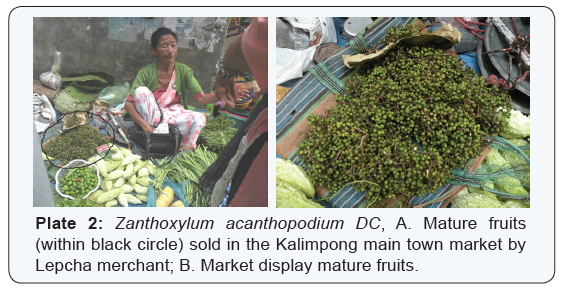Zanthoxylum Acanthopodium DC. (Rutaceae) - A Favourable Ethnomedicinal Fruit for The Local Inhabitants of Darjeeling Himalaya of West Bengal, India
Rajendra Yonzone1* and Samuel Rai2
1Taxonomy and Ethnobiology Research Laboratory, Cluny Women’s College, India
2Directorate of Cinchona and Other Medicinal Plants, India
Submission: November 18, 2016; Published: December 01, 2016
*Corresponding author: Rajendra Yonzone, Taxonomy and Ethnobiology Research Laboratory, Cluny Women’s College, P.O Kalimpong, District Darjeeling, WB, India, Tel: 91 9749793033 E-mail:ryonzone99@gmail.com
How to cite this article: Rajendra Y, Samuel R. Zanthoxylum Acanthopodium DC. (Rutaceae) - A Favourable Ethnomedicinal Fruit for The Local Inhabitants of Darjeeling Himalaya of West Bengal, India. J Complement Med Alt Healthcare. 2016; 1(1): 555554. DOI:10.19080/JCMAH.2016.01.555554
Abstract
Present paper deals with the ethnomedicinal fruit Zanthoxylum acanthopodium DC. Rutaceae, used by the local inhabitants of Darjeeling Himalaya of West Bengal, India. Local inhabitants of the regions are Lepcha, Sherpa, Bhutia, Tamang, Limbu or Subba, Bhujel or Khawas, Sunuwar or Mukhia, Rai, Thapa or Manger, Chettri, Bahun or Sharma, Newar or Pradhan, Kami, Damai, Sherki etc. Zanthoxylum acanthopodium DC. is sparsely found in the sloppy, barren and forest lands within an altitudinal range 1200-2800 m. Plant pricky woody shrub, flowering in the month of April and persist till May and fruit in June to October. It was observed that mature fruits are edible in the form of pickle and used in case of gastritis. Some fruits available in the market and people with taste of it buy this fruit at any cost annually. They keep it in the form of pickle to eat later.
Introduction: Darjeeling is the Northernmost hilly district of West Bengal which lies between 27º31’05” and 26º27’10” North latitude and between 88º53’00” and 87º59’30” East longitude. There are four Sub-Divisions viz., Darjeeling, Kalimpong and Kurseong which are hills and Siliguri falls under plain. The aim of the present investigation is to find the ethnomedicinally important fruit Zanthoxylum acanthopodium DC. used by the local inhabitants and to record the flowering time, common name, local distribution, general distribution, means of propagation, soil type, plant parts used, ethnomedicinal uses throughout the region.
Methodology: The ethnomedicinal informations are collected from senior resourceful citizens, school teachers, herbal practioners, spiritual healers like Jhankri, Dowa, Mangpa, Dhami, Bijuwa, Bungthing, Mata, Vendors, Bhagawati, Phedangma, Bonbo, Puimbo, Ghyapring, Dolma, Lama and Priests of all ethnic groups of Darjeeling Himalaya.
Results: Wild edible fruits are the important source of dietary supplement for local inhabitants. Mature fruits of Zanthoxylum acanthopodium DC. cannot be eaten more than one or two number of fruits at a time by a person. It has typical fragrance which comes after crushing fruits which is liked by the locals. Local inhabitants of the regions are very much familiar with this fruits and frequently used in case of gastritis and in the form of pickle both raw and preserved.
Conclusion: The fruits are preserved in the form of pickle to eat during off season. A single fruit is fatal for pig (a personal communication).
Keywords:: Zanthoxylum Acanthopodium DC; Ethnomedicinal fruit; Darjeeling; Himalaya; India
Introduction
Darjeeling is the Northernmost hilly district of West Bengal which is a part of the Eastern Himalaya and it lies between 27º31’05” and 26º27’10” North latitude and between 88º53’00” and 87º59’30” East longitude. The total area of the district is 3254.7 sq. km. There are four Sub-Divisions viz., Darjeeling, Kalimpong and Kurseong which are hills and Siliguri falls under plain (Figure 1). The altitude of the district varies from ± 130 m at Siliguri to as high as 3660 m at Sandakphu. During field studies in the regions revealed a huge wealth of traditional
knowledge on ethnomedicinal plants and their uses amongst the people. Extensive field survey was conducted to the study areas and collected authentic and valuable information. The specimens were collected without uprooting and disturbing in the nature and properly worked out both in the field and the laboratory and pressed in blotting paper. Finally, the specimens are preserved in Taxonomy and Ethnobiology Research Laboratory of Cluny Women’s College, Kalimpong. It is found that mature fruits of Zanthoxylum acanthopodium DC. is ethnomedicinally important and largely used in case of gastritis and edible in the form of pickle in their daily food by the local inhabitants of the district. The region harbour large number of plant species with wide range of diversity and distribution. This region was explored by Sir J. D. Hooker 1848-49, and mentioned in his work Flora of British India [1]. Cowan & Cowan [2] and Biswas & Chopra [3], have contributed major report in medicinal plants of Darjeeling and Sikkim regions. The medicinal and ethnomedicinal plants of the region and their uses are partially studied by workers like Yonzone et al. [4]; Yonzone, [5]; Rai et al. [6], Rai & Bhujel [7], Yonzone & Bhujel [8], Rai et al. [9], Yonzone et al. [10-14]. Flora of Bhutan by Grierson & Long [15] and by Noltie [16] also have studied to carry out this work.

Materials and Methods
The ethnomedicinal informations are collected during the year June 2007 to June 2009 and November 2013 to October 2016 through interviews from senior resourceful citizens, school teachers, herbal practioners, spiritual healers like Jhankri, Dowa, Mangpa, Dhami, Bijuwa, Bungthing, Mata, Vendors, Bhagawati, Phedangma, Bonbo, Puimbo, Ghyapring, Dolma, Lama and Priests of all ethnic groups of Darjeeling Himalaya. Group discussion was also arranged with the informants in local language (Nepali vernacular). As per the suggestion of interviewed people and the literatures, all the ethnomedinical plant species were collected during flowering times covering all the seasons of the year without uprooting and disturbing the nature. The collected specimens were worked out in the field and pressed in blotting paper and pressed. Identification and authentification of identified specimens was done in the herbaria at Central National Herbarium, Botanical Survey of India, Sinpur, Howrah and Sikkim circle (Gangtok) and finally from Department of Botany, North Bengal University, Rajarammohunpur, district
Darjeeling. Necessary photographs were collected. Herbarium preparation, identification and documentation work was done in the Taxonomy and Ethnobiology Research Laboratory. The aim of the present investigation is to find the ethnomedicinally important fruit Zanthoxylum acanthopodium DC. used by the local inhabitants in case of gastritis and edible in the form of fresh and preserved pickle and to record the flowering time, common name, local distribution, general distribution, means of propagation, soil type, plant parts used, ethnomedicinal uses throughout the region.
Botanical Description
Perennial erect shrub with spiny stem (Plate 1: A,B,&C), 250- 300 cm tall. Branches brown tomentose. Leaves odd-pinnate, 10-30cm long, ovate, lanceolate to oblong, acute, margin serrate; wings 0.8-1.2cm broad between leaflets (Plate 1: D&E). Flowers in subumbellate panicles. Male flowers; calyx-lobed, petals 4, ovate-elliptic, stamens 4, female. Flowers; calyx and corolla as in male flowers; carpels 4, ovoid, styles cohering. Ovary 2-5, carpellate, Fruit berry, ovoid and glandular (Plate 1: F,G,H&I).

Soil type:In natural habitat, it is preferably grown in less acidic to moderate acidic soil with pH 3 - 4.5. Sandy loam, clay to red lateritic soil is best for its cultivation.
Plant parts used:
Mature fruits, bark, leaves and roots.
Chemical constituents
The leaves of Zanthozylum acanthopodium DC, obtained 58 commpounds, with 75.6% of the oil and important compounds were linalool (14.3%), 9,12-octadecadienol (8.4%), 1.8-cineole (7.7%, 2-undecanone (7.3%), farnesol (3.6%), 9,12,15-octadecatrienol (3.2%), β-caryophyllene (3.0%) and phytol (3.0%) with other seven trace compounds (less than 0.02%) [17].
Ethnomedicinal uses
Local: Mature fruits are eaten in case of gastritis, stomach colic and liver complain, fruits are used as anti typhoid, gastritis, liver disorder and toothache. The bark and seeds are used as a tonic in fever and bowel complaints. It is supposed to possess stomachia and carminative properties. In the ayurvedic medicine, the bark, fruits and seeds are extensively employed as carminative, stomachic and anthelmintic. The fruits are used for gums and dental disorders as dyspepsia and lotion for scabies. Fresh roots are used to cure dental problem. An essential oil derived from the dried fruits is used in the preparation of tooth powders.
Results and Discussion
Wild edible fruits are the important source of dietary supplement for local inhabitants of certain geographical region of the country. The tribal population are eagerly engaged to eat such wild fruits and vegetable items for their survival. Similarly, Zanthoxylum acanthopodium DC. is such a fruit which cannot be eaten more than one or two number of fruits at a time by a person. It has typical fragrance which comes after crushing fruits which is liked by the locals. People of the region mainly ethnic groups like Lepcha, Sherpa, Bhutia, Tamang, Limbu or Subba, Rai, Thapa or Manger, Newar or Pradhan, Bhujel or Khawas, Sunuwar or Mukhia, Chettri, Bahun or Sharma, Kami, Damai, Sherki are very much familiar with this fruits and frequently used in case of gastritis and in the form of pickle both raw and preserved. Once fruit is craushed inside mouth using teeth causes breethlessness leading to death of the eater. However, any person suffering by breathlessness after causing Zanthoxylum acanthopodium DC. fruits is given a pinch of fine soil, he quickly recovers. In fact eating of soil is the only immediate solution to this problem (mother’s instruction to the last author during childwood which they practically experimented among brothers during their childhood taking fruit). Fruits are sold in the markets of Kalimpong (Plate 2: A&B), Darjeeling and Kurseong in the month of June -August.

Conclusion
The fruits are preserved in the form of pickle to eat during off season along with chilli as “achar”. It looses its breedthlessness property once it is preserved using salt which makes it convinent to use. A single fruit is fatal for pig (a personal communication).
Acknowledgements
All the people who were interviewed during survey period are acknowledged for their help and cooperation with the team.
References
- Hooker JD (1872-1897) Flora of British India. Vols. I-VII. International Book Distributors, Dehra-Dun, India.
- Cowan AM, Cowan JM (1929) The trees of North Bengal including shrubs, woody climbers, bamboos, palms and tree ferns. Bengal Secretariat Book Depot, Calcutta, India.
- Biswas KP, Chopra RN (1956) Common medicinal plants of Darjeeling and Sikkim Himalayas, Alipur, Calcutta, India.
- Yonzone GS, Yonzone KN, Tamang KK (1984) Medicinal plants of Darjeeling district. Jour Eco Tax Bot, Jodhpur, India, 5(3): 605-616.
- Yonzone GS (1996) Medicinal plants in the Darjeeling district. Proc. Medicinal plants, Herbal drugs and Rural health. Max Muller Bhavan, Calcutta, India, pp. 102-111.
- Rai PC, Sarkar A, Bhujel RB, Das AP (1998) Ethnobotanical studies in some fringe areas of Sikkim and Darjeeling Himalayas. Jour Hill Res, Sikkim, India, 11(1): 12-21.
- Rai SK, Bhujel RB (1999) Note on some less known ethnomedicinal plants from the Darjeeling Himalayas. Jour Hill Res, Sikkim, India, 12(2):160-163.
- Yonzone Rajendra, Bhujel RB (2009) Medicinal and Aromatic Plants of Darjeeling District and Documentation of Status Habitat and local Uses of the Plant Species, Project Report. WBSCST, Kolkata and Cluny Women’s College, Kalimpong, Darjeeling, India.
- Rai Anita, Rai Samuel, Yonzone Rajendra (2013) Ethno Medicinal Plants used by the People of Darjeeling Hills in the Eastern Himalaya. Universal Jour Pharmacy 2(1): 122-134.
- Yonzone Rajendra, Rai Samuel, Bhujel RB (2012a) Kaempferia rotunda L. (Zingiberaceae) A potential medicinal herb cultivated and used by the local inhabitants in bone fracture, sprain and joint dislocation in Darjeeling hills of West Bengal, India. Jour. Interacademicia 16(1): 20- 25.
- Yonzone Rajendra, Bhujel RB, Rai Samuel (2012) Genetic resources, current ecological status and altitude wise distribution of medicinal plants diversity of Darjeeling Himalaya of West Bengal, India. Asian Pacific Jour Trop Biomed S439 -S445.
- Yonzone Rajendra, Bhujel RB, Rai Samuel (2012) Genetic diversity of Ethnobotanical and Medicinal plants resources of Darjeeling district, West Bengal, India. Int Jour Adv Phrm Res (IJAPR) 3(1): 713-729.
- Yonzone Rajendra, Rai Samuel, Bhujel RB (2012) Ethnomedicinal and Aromatic Plant Diversity and Resources of Darjeeling district of Eastern Himalaya in India. Int Jour Adv Phrm Res (IJAPR) 3(4): 859-871.
- Yonzone Rajendra, Bhujel RB, Rai Samuel (2012e) Medicinal Wealth of Darjeeling Hills used Against Various Ailments. Ad Plant Sci 25(II): 603-607.
- Grierson AJC, Long DG (1983-2001) Flora of Bhutan. Vol.-1 part 1 & 2, 3; Vol.-2 part 1, 2 & 3. Royal Botanic Garden, Edinburgh.
- Noltie HJ (1994-2000) Flora of Bhutan. Vol.-3, part 1 & 2. Royal Botanic Garden. Edinburgh.
- Rana S Virendra, Blazquez M Amparo (2008) Terpenoid Constituents of Zanthozylum acanthopodium DC Leaves. Jour Essential Oil Res 20: 515-516.





